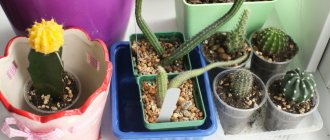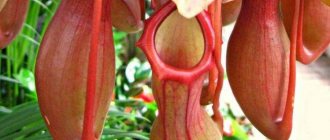Epiphyllum is a succulent perennial flower from the cactus family, genus Epiphytes. There are two dozen species in nature. Translated from Greek as “flower on leaves.” Places of distribution: South and Central America, subtropics of Africa, Mexico. It grows there on tree trunks and branches. Unlike plants, which receive energy from the tissues of the “host”, it feeds on its own. Used as an indoor flower, decoration of the garden, balcony, loggia.
What does epiphyllum look like, what family does it belong to?
Epiphyllum is a flower that belongs to the cactus family, there are 20 species. The name is of Greek origin, translated “to the leaf.” This combination of words occurred due to the similarity of the stem in shape with the leaf. The culture is found in the wild in the tropics of South America and the forests of Mexico.
Epiphyllum Monstrosa is sometimes called pink
Common varieties
There are hybrid and natural plant varieties. They differ in the shape of the leaves and the size of the flowers. Many can be grown on the windowsills of apartment buildings if you care for them properly.
- Epiphyllum Marniera is a forest cactus, represented by long, flat shoots that are strongly dissected into leaf-shaped lobes. The diameter of the white flower is on average 25 cm. In the center of the bud there are fluffy golden stamens with a pleasant smell. The plant blooms at night.
- Epiphyllum Monstrosa or Guatemala is notable for its long, twisting stems. For the various shades of light red flowers, this variety is also nicknamed pink epiphyllum.
- Epiphyllum Anguliger grows only in Mexico. The angular epiphyllum received its nickname due to the ornate shape of the stems. The stems can grow up to 1 meter in height, the flowers are large - 15 cm in diameter, and have a pleasant smell. The lower leaves of Epiphyllum anguliger become woody over time.
- Epiphyllum Oxypetalum in nature can grow up to 3 meters long. The plant has flat, narrow, hanging stems that reach a length of 10 cm. The snow-white flowers of Epiphyllum oxypetalum open at night and fill the room with a tart aroma.
- Epiphyllum Ackermann is often found in apartments. The plant is represented by 3-sided hanging stems, along the edges of which there are rounded notches. The leaf blades are 5 cm wide and grow up to 60 cm in length. Up to 15 buds can bloom simultaneously at the tops of the peduncles. The most common red flowers are epiphyllum. Thanks to their ampelous shape, the bushes can be grown in flowerpots, hanging them on the wall.
- Epiphyllum acupetallus was named so for the pointed shape of the stems, which have the shape of narrow, long leaves. The second name is Epiphyllum White, for the exceptionally white hue of the flowers, which in their shape resemble lotuses.
Attention! Many varieties of epiphyllum are suitable for home cultivation. The main thing is to know and follow the rules of flower care.
All varieties of crops require moderate watering and good lighting.
Epiphyllum anguliger has large flowers
Description of epiphyllum
Thick, long and flexible stems of the epiphyllum are flat, with a noticeable vein in the center, jagged on the side, and sometimes triangular or wavy. The shoots branch and form a dense bush. Over the years, the base becomes woody and covered with brown bark. At the edges of the stems there are areoles with short spines in the form of bristles.
The number of aerial roots increases with high humidity. The buds are tubular in shape, some varieties are up to 40 cm long. They open at night and close in the morning. Flowers of vanilla white, pink, red shades exude a pleasant aroma. They appear in spring and summer, some species in autumn. The fruits are large, edible, and grow at home only if there is cross-pollination. They resemble plums in shape and size, and taste like strawberries and pineapple.
Features of caring for a cactus at home
Echinopsis cactus - home care
The flower cannot be moved from its permanent place on a window or wall. The bush may begin to shed buds and flowers.
Temperature
The optimal summer temperature for the flower is 20-25 °C. In autumn, the plant is moved to a cooler room. During the rest period, the heat level in the room should not exceed 15 °C.
Lighting
From the bright sun, the stems of the plant begin to wrinkle and turn yellow. The pot can be placed on the east side; on the south window sill it is necessary to shade the direct rays of the sun. In summer, it is recommended to move the flowerpot outside so that the plant receives more oxygen. But in an open space, the risk of pest infestation increases.
Watering
Watering the bush should be moderate, otherwise it will rot. Before moistening the flower, make sure that the soil in the pot is completely dry. The plant is watered with melted or boiled water at room temperature. In winter, watering is halved; if the room is very cold, watering is stopped altogether.
Long drought leads to drying of shoots and lethargy of leaves. To stimulate the growth of buds, the amount of watering is increased.
Humidity
The plant loves moist air; the stems need to be irrigated daily with a spray bottle. The need for humidity increases if the room where the epiphyllum grows is hot. But a long stay in wet soil can lead to fungal diseases.
The result of excessive watering is the appearance of fungus
Priming
The tropical plant prefers soil rich in mineral elements. You can make the substrate yourself by mixing sand and humus 4 to 1. The soil should be of high acidity.
Feeding
During the flowering period, the plant is fed with cactus fertilizer once every 2 weeks. Fertilizing with a solution of manure in a ratio of 1:4 has a beneficial effect on the ovary of buds.
Care
There are usually no special difficulties with growing Epiphyllum, and the process itself is practically no different from how other cacti are grown. However, in this section, we will tell you how to grow this type of cacti at home and consider such important points as:
Location and lighting
Since Epiphyllum is a forest cactus, it does not like too bright sun, therefore, the best option would be an eastern window or any other, but slightly darkened one. The plant loves light, but remember to avoid direct sunlight. During the dormant period, additional artificial lighting is not required.
Temperature
The most optimal temperature for a cactus is 23-25 degrees Celsius, and in winter and the rest period - from 10 to 15. Air humidity should be slightly above average, but if you do not have the opportunity to create such conditions, then it’s okay - the plant quickly adapts to any humidity, even the lowest.
Watering
From November to March, watering should be minimal - 1-2 times a month, with warm water. In spring and summer, the cactus should be watered more often, but the main thing is not to overdo it. Check the soil moisture yourself. Most importantly, do not let the soil dry out. If the soil is loose, dry, but slightly moist, this means it’s time to water. Use lukewarm water, but never from the tap.
Feeding with fertilizers
Fertilizing is best done during the period of active growth or flowering. Usually, this moment falls in spring and the first month of summer. The plant should be fed once a week or two, it all depends on the fertilizer. Usually the packaging indicates the timing and dosage. It is best to use mineral fertilizers themselves, with a high content of calcium, potassium and phosphorus, but without nitrogen!
A high nitrogen content will simply destroy the cactus, remember this.
The soil
Young plants need good soil. As a rule, up to three to five years of age, ready-made soil is used, which is sold in flower shops. After this age, the land is made independently. To prepare the soil at home, you will need:
- Peat
- Ordinary land
- Sand
- Charcoal or earth
- Small crushed stone or crushed brick
- A little humus (compost)
It is necessary to mix all the ingredients in the following proportion 1:1:1:1:1:2 (you can use more compost). Be sure to mix everything well. This way, you will have ready-made soil that can be used at any time, for example, for replanting.
Older plants need almost peat soil, with a small content of compost and sand.
Transfer
Once every 2-3 years, Epiphyllum, and any other type of cactus, should be replanted. The plant needs replanting for further growth, and the soil still wears out, no matter how you fertilize it. For transplantation you will need:
- soil (ready or prepared yourself);
- drainage (expanded clay, crushed stone, brick chips);
- pot.
In a new pot, place a layer of drainage on the bottom so that it is 3-4 cm thick. Then, pour a little soil on top of the drainage. Now, you need to remove the cactus from the old pot. This is done simply - turn the pot over and knock on its bottom. Just do all this carefully, since Epiphyllum has spreading stems and can be easily damaged.
When the cactus is removed, shake off the root system a little from the old soil and place it in a new pot. All that remains is to fill the container with soil and water. If the transplant is carried out during the active growth phase, then fertilizing with fertilizer should also be done.
Trimming
Since Epiphyllum is quite spreading, the plant should be pruned periodically, every 3 years. This is easy to do. Use a sharp knife to safely remove damaged and improperly growing stems. You should also cut off those stems that already had flowers 2 years ago. It will not be possible to see new flowers on them, and they will interfere with the plant. You should also remove those shoots that have never bloomed.
After pruning, be sure to sprinkle the cut areas with charcoal or ash.
Rest period
The resting period of the cactus begins from the end of October until March. At this time, you should not disturb the cactus, do not touch it again or rearrange it. Temperature 10-15 degrees. Watering is carried out rarely and in very small dosages - 1-2 times a month, several tablespoons of water. Water at room temperature. It is also worth mentioning that at this time, you can fertilize with certain types of fertilizers that are designed specifically for cacti.
Also read: Ripsalidopsis is the closest relative of Zygocactus
Bloom
Depending on the species, Epiphyllum can bloom up to twice a year - in spring and early autumn. The most important thing is, as soon as you see the formation of buds, do not touch or turn the pot under any circumstances, otherwise you can ruin everything. At this time, cacti are very sensitive to any actions. If your pet does not bloom, then there may be several reasons:
- First of all, age. Usually, the first flowering of cacti is possible in the second or third year.
- If everything is in order with age, it means that mistakes were made in caring for the plant.
- Watering is disrupted, there is a lack of light, incorrect conditions are created during the dormant period, etc. All of this affects whether your cactus will bloom or not. So, keep that in mind.
- Well, as a consolation, we can add that there has never been a cactus that has never bloomed!
Reproduction
The propagation of Epiphyllum is no different from other types of cacti. You can do this in several ways:
- Seeds;
- Cuttings;
- By division.
Now a little more about each of them:
Seeds
In one of the previous articles, we wrote about how to grow cacti from seeds, so in order not to repeat ourselves, we recommend that you familiarize yourself with it. In short, the seeds are taken, soaked in a light solution of potassium permanganate, and then sown in a greenhouse with special soil. Then, we should expect the emergence of seedlings, and after 3 months, the seedlings are planted in separate pots.
Cuttings
To propagate by cuttings, you will need:
- Sharp knife;
- Soil for cacti;
- Pot;
- Sand.
First of all, prepare a new pot where the cutting will be planted. It is better to choose a pot that is not too high and wide. Next, it needs to be filled with soil, about 5-6 centimeters.
The next stage is preparing the cuttings. To get a cutting, select a healthy and young stem from a cactus, and then, using a sharp knife, cut off a part 10-15 cm long. After this, the cutting must be removed to a windowsill or any other place for 2-3 days, so that it is slightly dried out. After the cutting is ready for planting, make a small hole 2-3 cm deep in a ready-made pot and plant the seedling in it. When everything is done, take the sand and pour it into the pot in even layers, 1.5-2 cm thick.
Remember, the first watering of the cutting can only be done on the third day after planting.
Division
This method can be used when transplanting a cactus to a new location. When you remove the plant from the pot, shake the root system off the soil and see how much of the cactus can be separated. This is easy to do - the most important thing is that the part that you will separate has good and healthy stems, as well as intact roots.
As soon as you find such a part, separate it from the main plant using a knife, and be sure to sprinkle the cut area with ash or crushed charcoal. Next, plant the resulting plant in a pot like an ordinary cactus and begin caring for it. Nothing complicated!
Also read: Cacti with names starting with the letter “A” - list of species
Features of care in winter, rest period
Gymnocalycium cactus - home care
In winter, the air temperature should be lowered to 12-15 °C, this will ensure flowering next season. Watering less often than in winter; at low room temperatures, watering is extremely rare.
Important! There is no need to force the plant to bloom in winter; during this period, the epiphyllum must rest in order to gain strength for further development.
Transplantation and pruning of epiphyllum are not carried out in winter.
Conditions and care
The lighting is bright and diffused. Direct summer sunlight can cause burns, but a lack of light will cause deformed shoot growth and the plant may not bloom.
The soil is loose, epiphytic, slightly acidic. Standard soil from flower shops for aroids or bromeliads is quite suitable. About a third should be coarse material that drains well and prevents caking of the soil (small fragments of bark, perlite). To maintain the acidity of the substrate when watering with hard water, you can add sphagnum, high peat to the soil mixture, or acidify the irrigation water with lemon juice.
Watering . In summer, water regularly and moderately, and always keep the soil slightly moist. Water with warm water after the top layer of soil has dried, without waiting for the entire volume to dry completely. Be sure to water from above, not from the tray; be sure to remove excess water from the tray after watering. Overdrying the coma has a detrimental effect on the condition of the roots; waterlogging or choosing too heavy soil will lead to blockage of the capillaries, air will not be able to reach the roots, which will cause them to rot. In winter, it is necessary to reduce watering, but not allow the soil to dry out completely.
Air humidity is high, at temperatures above +18 o C it is advisable to spray the stems several times a day; on hot days, spraying is simply necessary.
Feeding . It is necessary to apply universal fertilizer only from spring to autumn, in small doses.
Temperature . In summer, the optimal temperature is +22+28 o C. From autumn to spring, it is necessary to slightly lower the temperature, to +16+18 o C. It is undesirable to allow temperatures below +15 o C. It is important to remember the heat-loving nature of this species when growing it together with other forest cacti, many of which tolerate cooling down to +5+7 o C.
Flowering usually occurs in winter. To set buds, a period of relative rest is required in September-October, when the abundance and frequency of watering decreases and the temperature drops. A strong drop in temperature (to low positive values) can lead to the dropping of buds and damage to the plant. After flowering, another period of rest begins until spring, when coolness is also maintained and watering is reduced.
Diseases and pests . At home, it is possible to be affected by mealybugs and scale insects. If kept too cold, fungal diseases are possible. See the article Pests of indoor plants and measures to combat them.
When and how does it bloom
Echinocactus Gruzoni - planting and care at home
At the end of February, buds are laid on leaf-shaped stems, which, under the right conditions, will open into large flowers. It is important at this time not to move or turn the pot with epiphyllum, otherwise the ovaries will fall off.
Flowers appear twice a year - in spring and autumn, flowering lasts for 5 days. But this only happens with good care. During the flowering period, the bush is watered abundantly and fertilized more heavily.
The plant has a variety of shapes and colors of flowers. What the inflorescence looks like depends on the variety. These can be small funnel-shaped flowers up to 10 cm in diameter or giant fluffy inflorescences up to 25 cm in diameter.
The appearance of epiphylum flowers depends on the variety
Changes in care during the flowering period
When the plant blooms, it is fed twice as often as at normal times. Watering also increases; the flower needs more nutrition. Make sure that enough light reaches the stems of the bush.
Flowers do not appear twice on the same stems. Peduncles are not cut off immediately after the flowers fall; the green mass is needed for the development of the bush. You can carry out preventative pruning of old stems.
You should know! Excess nitrogen fertilizer is one of the reasons why epiphyllum does not bloom.
Types and varieties of epiphyllum
Varieties are characterized by size, number of buds, and color. There are almost two hundred species.
| Variety | Description |
| Marniera yellowheart (Selenicereus) | It stands out for its spreading shoots, large and long flowers up to 25 cm. |
| Oxypetalum | Found on rocks and tree crowns. Fleshy narrow wavy stems up to 6 cm long and 12 cm wide, up to 3 m high. It is nicknamed the “queen of the night” because of the white, large wavy flowers that bloom at night. They have a pleasant smell, diameter up to 17 cm. |
| Guatemalan | The varieties differ in the appearance of the stem. The first resembles a chain of oak leaves, the length of each link is up to 5 cm. The second, Monstrosa, has darker shoots that are not divided into parts and grow twisting at random, changing shape. The flowers are pink with different shades. |
| Ackerman | Thin, jagged stems with bright red flowers. Often grown in hanging pots. It grows slowly. |
| White or holly | The stems are oval, pointed, up to 30 cm, 12 cm wide. Snow-white and cream petals bloom at night with a pleasant, persistent aroma. |
| Angulireg or angular | Meter-long, strongly branches in the form of a zigzag. The petals are fragrant, yellow, white, pink. |
| Phyllanthus | In its natural environment it lives on the crowns of trees. Rich green color with soft pink flowers, in the center of a yellow tint up to 30 cm. Corolla diameter up to 18 cm. |
| Hooker | His homeland is Venezuela, Mexico, Cuba. It grows to large sizes, the arched stems are rigid and hang down due to their own weight. The petals are white, long, fluffy in the middle. |
| Jagged | Small bushes, blue-green. Long erect stems up to a meter with narrow leaf blades, without thorns. It opens yellow, the corolla has a diameter of 15 cm. |
| Lau | Grows quickly, 3 m long, 7 cm wide with yellow-brown needles. Cream buds open in the evening and last for two days. |
| Just Prue | The variety was bred in a nursery, features rapid adaptation to the environment, loves a temperature of +18 °C. Flowering comes with spring. The color is pink in the middle to dark pink at the edges. Corolla diameter up to 16 cm. |
| Dreamland | Petals are pink, orange, white, red and appear in summer. Has medicinal properties. |
| Thomas | In nature it reaches up to 4 meters, but at home it grows only up to 70 cm. It blooms white, the areoles are pubescent. |
| Round-toothed | Stems are gray-green, flat. The base is cylindrical, wavy on the sides, and contains areoles with setae. There are shades of cream and green with a pleasant aroma. It opens during the day, which is unusual for epiphyllum. |
| Paul de Lonpre | It is distinguished by long shoots, leaning towards the ground, and large flowers with a diameter of 14 cm. The color is cream, with a red edge. A hybrid species of rounded-toothed and selencerius. |
How does epiphyllum reproduce?
There are several ways to propagate epiphyllum.
Germination of seeds
To germinate seeds, you need to wait until the epiphyllum blooms, which produces the first flowers only by the 5th year of life. After successful pollination, fruits are formed in which the seed will ripen. It is sown in nutritious soil and covered with glass.
In order to get seedlings, the temperature in the room is maintained at least 23 °C, the pot is placed near a window with good lighting. Every day the greenhouse is ventilated for several hours and watered if necessary. After the emergence of seedlings, the shelters are removed and the temperature regime is maintained for further growth of the stems.
Rooting cuttings
This is the easiest and most effective way to propagate a plant. Select healthy stems of an adult bush and cut them into pieces 10 cm long. Place the cuttings in a dark place for 2 weeks until the cuts begin to shrink. Then the cuttings are planted in a shallow tray with a nutritious moist mixture. There should be a drain hole at the bottom. Cuttings can be rooted in light soil that is well-ventilated.
Propagation by cuttings is the easiest way
Dividing the bush
An adult bush has shoots with its own roots; it can be divided into several parts. This procedure is carried out in the summer, after the flowers fall. Carefully remove the bush from the pot, divide the rhizome into segments and transplant the bushes into a prepared container with a nutrient mixture. At first, watering is moderate; you need to monitor how the seedlings take root in the new place.
Methods for propagating epiphyllum
Medinilla flower: home care and propagation methods
Epiphyllum is characterized by propagation by cuttings and seeds; each method has advantages and disadvantages.
Cuttings in pots
Seeds
Epiphyllum can be grown from seeds, which will require:
- Seeds;
- A pot with low sides;
- Substrate for cacti and succulents;
- Glass or polyethylene;
- Drainage (pebbles, foam);
- Spatula.
How to grow:
- Drainage is laid out in one layer at the bottom of the pot, and 3-4 cm of substrate is poured on top of it. Everything is abundantly irrigated with water;
- The seeds are evenly laid out on top; they need to be sprinkled with a small amount of substrate. They should be recessed by 5-6 mm;
- The pot is covered with plastic wrap or covered with glass. It should stand in a well-lit place at a temperature of 20-25°C;
- Every day the crops must be ventilated by opening the glass or film for 45-50 minutes. After 2-3 weeks, the protective layer is removed;
- The sprouts can be transplanted into separate pots when they reach a size of 4-5 mm in length.
The substrate with seeds must always be moist; for this, it is irrigated with water from a spray bottle. Over time, the stems acquire a flat shape; plants grown from seeds will bloom only after 5 years.
Cuttings
Epiphyllum cactus is propagated by cuttings from mid-April to early May, what needs to be done:
- Cut off the end of any stem 5-10 cm long. If the width of the cutting is more than 5 cm, it needs to be made narrower to the base. Its width should be within 3-5 cm;
- The cutting should dry at room temperature; to do this, place it on a clean sheet of paper and leave for 1-2 days;
- A drainage layer is placed at the bottom of the pot, and soil is poured on top;
- The shoot is planted in prepared moist soil to a depth of 5-7 mm. If it is not stable, you should tie the cutting to a peg.
Note! Cuttings take root well at any time of the year if there is enough light in the room. During the winter season, artificial lighting can be used.
The first day after planting, the shoot should not be watered; it should be in the shade. After 2-3 weeks, roots will form, all this time the soil should be moist, without excess dampness. The cuttings are cared for like an adult flower; in 1-2 years the epiphyllum will bloom.
Many plant lovers choose epiphyllum for their home; caring for this plant at home does not require a lot of time and resources. It is called the “Orchid Cactus”; the flowers of the epiphyllum have different shapes and sizes, and differ in color. If you properly care for the cactus, it will delight you with abundant flowering every year.
Transfer
Many have seen bright lush cactus flowers on other people's windowsills. Hardly anyone doesn’t know how beautiful the epiphyllum is when it blooms, and how to make this exotic bush bloom if it doesn’t want to produce buds for a long time. Transplantation will help stimulate flowering.
You need to replant the flower if the bush has grown enough and the old pot is no longer enough for it. The plant should be transferred to a new container before flowering to reduce stress on the tree.
Interesting! Flowers appear in the buds of the stem only once during its growth cycle. Subsequently, the buds bloom on new peduncles.
After the soil in the flowerpot has dried, carefully remove the roots and clean them from the soil. Rotten and damaged roots are removed, and the sections are sprinkled with activated carbon. Plant the flower in a container not much larger than the previous one. The bottom of the pot is covered with drainage made of expanded clay or pebbles, a portion of the soil is filled in, the rhizome is placed on it, and the substrate is added to the growing point of the flower. Moisten the soil abundantly.
Diseases and pests
Unfortunately, Epiphyllum, like other cacti, is attacked by pests and diseases. Some things can be cured, but there are also diseases that make themselves felt too late, when the plant has already died. Below, the most common pests and diseases of Epiphyllum will be listed.
The mealybug is easy to recognize - it is a white insect that leaves a white coating on the stems. You can fight it in different ways. The fastest way is to spray with a special preparation, but you can do without it. To do this you need alcohol and a cotton swab.
Soak the tip of a cotton swab in alcohol and go over all the places where there is a white coating, as well as over the insect itself. You can completely wipe the entire plant, this will only be a plus. After alcohol treatment, make a soap solution and thoroughly spray the cactus with a spray bottle, then let it stand for 10-15 minutes. Then, the plant should be washed with lukewarm water.
Aphids, spider mites and scale insects are other pests that are found quite often on cacti. The best way to combat them is to treat them with special preparations, usually in two stages. The break between spraying is approximately 7-10 days, no more.
Black rot - this disease can be identified by the black spots that appear on the stems. Infected areas must be cut out, and if this is not possible, then the affected stem must be completely removed. All cut areas are sprinkled with ash, and the cactus is sprayed with the preparation.
Dry rot is the most insidious disease from which the plant cannot be saved. Signs of damage in the form of drying stems appear too late, when nothing can be done to help.
Rust - the main symptoms are brown and reddish spots that appear throughout the plant. The reason is improper watering, especially during the dormant period and low water temperature. It is treated by treatment with a special drug.
Fusarium is another disease associated with improper plant care. If the kash cactus begins to change color to burgundy or slightly reddish, then this is fusarium. The main reason is too frequent and excessive watering, which also affects root rotting.
For treatment, you can use a special preparation, but, as a rule, the plant is dug up, all damaged roots are removed and replanted in a new pot with new soil. Also, the first watering should be done no earlier than a week later and only with warm boiled water.
Basically, all diseases in Epiphyllum and not only are caused primarily due to improper care of the plant. At first glance, it seems that the cactus is unpretentious in care, but in reality everything is different and it needs to be given due attention and provided with the right conditions for development.
So, if your pet is attacked by fungi, it means you are doing something wrong.
Diseases
Epiphyllum without good care will become an object for diseases. The plant is susceptible to fungal infection and viral mosaic.
Viral mosaic infection is very difficult to cure
When a flower is watered with cold water, over time it becomes covered with round spots - these are signs of a fungal infection. Darkening is clearly visible on the stems. You need to dig up the bush, dry the roots, removing damaged ones, and treat the entire crown and roots with a fungicidal preparation. In the future, try not to flood the flower.
If small white spots appear on the stems, it means that the plant has become infected with viral mosaic. It is extremely difficult to save a diseased epiphyllum; it is better to prevent the disease by protecting it from contact with diseased flowers.
Beneficial and medicinal properties of Epiphyllum
The plant itself, its juice and fruits have valuable qualities:
- Some believe that the cactus protects against electromagnetic radiation;
- Phyllocactus juice is a diuretic - useful for edema;
- Cactus juice is used for cardiovascular, gastrointestinal and neurological diseases;
- The juice and fruits of the plant help with rheumatic pain;
- Cactus juice alleviates the condition of patients with psoriasis;
- Epiphyllum is used in the food industry for the preparation of candied fruits, drinks and desserts. Gourmets eat cactus raw and fried;
- Used for decorating rooms.
Pests
A neglected flower can be attacked by pests, among which the most common are aphids, scale insects, mealybugs, slugs, and spider mites.
The scale pest is very fond of epiphyllum.
Infected stems are washed with soapy water to remove traces of insect activity. To kill larvae and spores, the crowns are irrigated with an insecticidal preparation.
Not recommended! The plant is susceptible to pest damage. There is no need to place it next to new flowers that have not passed quarantine.
You should be careful when keeping a flowerpot on a terrace or balcony, as harmful insects often fly in from the street. They may attack the plant.
Pests and diseases
If not cared for properly, the flower is attacked by pests:
- Spider mite - a web appears. Treat with colloidal sulfur, Green soap, karbofos.
- Aphids - wipe with tobacco infusion, soda solution. Spray with preparations: Iskra, Fitoverma, Neoron, Decis.
- Mealybug - wipe the flower with alcohol or treat with garlic infusion.
- Scale insects - treat with soapy water, use Fitoverm, Aktar, Aktellik.
Epiphyllum is prone to fungal and viral diseases due to excessive watering, nutrient deficiency, and low temperature:
- Rust – yellow-brown spots are visible. This occurs from waterlogging at low temperatures or from sunburn. Treat with a solution of Topaz, Alirin.
- Black rot - black spots on the stems. Get rid of the affected areas and treat with Fundazol, disinfect the cut areas with activated carbon.
- Anthractosis - light brown spots. Trim infected stems, treat with Phyotosporin, Trichodermin.
- Fusarium - the stems turn red due to rotting roots. Change the soil, remove infected roots, treat with Gamair.
- Viral mosaic - small light spots on the plant, the tips dry out, the buds fall off. It cannot be treated; the infected flower is thrown away.
The flower withers when watered too much, and bright light causes the buds to fall off.
Signs and superstitions
There is a belief that if the epiphyllum blooms, you can soon expect a child to appear in the family.
The cactus protects the home from uninvited guests, the evil eye and bad thoughts. But you can’t give it as a gift, it will lead to separation from your loved one.
Single girls are not recommended to have a tropical flower; it scares away suitors.
A variety of types allows you to choose the right one
Everyone has seen the epiphyllum plant; caring for it at home is simple. If you follow the growing rules, you can make this tropical flower bloom and admire the falling flat leaves with large bright buds that will bloom at night.
Selenicereus hybrids Golden Heart
Along with other forest cacti, Selenicereus Golden Heart can also be used to breed new varieties of epicacti. So Eckhard Meier created a whole series of hybrid Epicacti under the general name Hunsrück (after the name of a mountain in Germany near his hometown of Simmern).
Crossing an epicactus cultivar similar to 'Moonlight Sonata' with Selenicerius chrysocardium produced 'Hunsruck Cub' with large carmine flowers, 'Hunsruck Charm' with large purple flowers, and 'Hunsruck Serenade' with large flowers with lavender inner petals. outer ones are purple.
By crossing the epicactus "Discovery" with Selenicereus chrysocardium, large-flowered varieties were obtained: "Hunsruck Champion" with dark orange-carmine petals and "Hunsruck Citron" yellow.
Hybridization of epicactus 'Flammenspiel' and Selenicereus chrysocardium produced the following large-flowered varieties: 'Hunsruck Feue' with shades of fiery orange and deep purple, 'Hunsruck Rubin' with shades of dark ruby to orange-red with a purple throat, and 'Hunsruck Silber' with silvery-white inner and slightly yellowish outer petals.
Features of epiphyllum
Epiphyllum, also called forest cactus or phyllocactus, is a spectacular succulent that is decorated with long branching shoots. They can be creeping or drooping, in some cases they have a wavy edge. The shoots are either triangular or flat; they have aerial roots. Inexperienced gardeners believe that these shoots are the foliage of a forest cactus.
The funnel-shaped large white flowers are about 0.4 m long. They open both during the day and at night. These flowers are very beautiful, which is why the plant is often called epiphyllum orchid. The large, pale red fruits may be covered in spines. They can be eaten and have a pleasant strawberry-banana-pineapple flavor. Most often this plant is cultivated indoors as a hanging plant.
Epiphyllum pruning
To preserve the decorative shape of the epiphyllum, it is necessary to trim it from time to time, removing shoots that are faceted or round in cross-section and do not produce flowers, and shortening flat ones.
When pruning flat shoots, it is worth considering that the formation of flowers occurs on the shoots of the previous year and those that previously bloomed will not bloom again, but their pruning can only be done after 2-3 years. This is due to the fact that they support the life of the entire plant.
Shoots with corky formations must be pruned without fail, and the plant must also be freed from stems and faded buds that are twisted or growing into the inner zone of the bush. It is better to treat the cut areas with crushed coal.











